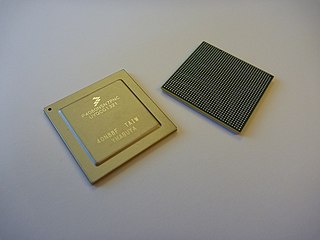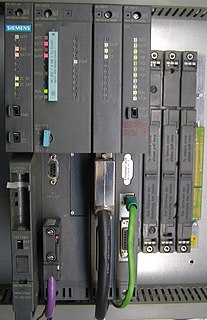AppleTalk is a discontinued proprietary suite of networking protocols developed by Apple Inc. for their Macintosh computers. AppleTalk includes a number of features that allow local area networks to be connected with no prior setup or the need for a centralized router or server of any sort. Connected AppleTalk-equipped systems automatically assign addresses, update the distributed namespace, and configure any required inter-networking routing.

Network topology is the arrangement of the elements of a communication network. Network topology can be used to define or describe the arrangement of various types of telecommunication networks, including command and control radio networks, industrial fieldbusses and computer networks.
The data layer, or layer 2, is the second layer of the seven-layer OSI model of computer networking. This layer is the protocol layer that transfers data between adjacent network nodes in a wide area network (WAN) or between nodes on the same local area network (LAN) segment. The data link layer provides the functional and procedural means to transfer data between network entities and might provide the means to detect and possibly correct errors that may occur in the physical layer.

A network interface controller is a computer hardware component that connects a computer to a computer network.
A distributed control system (DCS) is a computerised control system for a process or plant usually with many control loops, in which autonomous controllers are distributed throughout the system, but there is no central operator supervisory control. This is in contrast to systems that use centralized controllers; either discrete controllers located at a central control room or within a central computer. The DCS concept increases reliability and reduces installation costs by localising control functions near the process plant, with remote monitoring and supervision.

In computer hardware, a host controller, host adapter, or host bus adapter (HBA) connects a computer, which acts as the host system, to other network and storage devices. The terms are primarily used to refer to devices for connecting SCSI, Fibre Channel and SATA devices. Devices for connecting to IDE, Ethernet, FireWire, USB and other systems may also be called host adapters.
In telecommunications, trunking is a method for a system to provide network access to many clients by sharing a set of lines or frequencies instead of providing them individually. This is analogous to the structure of a tree with one trunk and many branches. Examples of this include telephone systems and the two-way radios commonly used by police agencies. Trunking, in the form of link aggregation and VLAN tagging, has been applied in computer networking as well.

A Medium Attachment Unit (MAU) is a transceiver which converts signals on an Ethernet cable to and from Attachment Unit Interface (AUI) signals.
Fieldbus is the name of a family of industrial computer network protocols used for real-time distributed control, standardized as IEC 61158.
Networking hardware, also known as network equipment or computer networking devices, are electronic devices which are required for communication and interaction between devices on a computer network. Specifically, they mediate data transmission in a computer network. Units which are the last receiver or generate data are called hosts or data terminal equipment.

Industrial Ethernet (IE) is the use of Ethernet in an industrial environment with protocols that provide determinism and real-time control. Protocols for Industrial Ethernet include EtherCAT, EtherNet/IP, PROFINET, POWERLINK, SERCOS III, CC-Link IE, and Modbus TCP. Many Industrial Ethernet protocols use a modified Media Access Control (MAC) layer to provide low latency and determinism. Some microcontrollers such as Sitara provide Industrial Ethernet support.

Show control is the use of automation technology to link together and operate multiple entertainment control systems in a coordinated manner. It is distinguished from an entertainment control system, which is specific to a single theatrical department, system or effect, one which coordinates elements within a single entertainment discipline such as lighting, sound, video, rigging or pyrotechnics. A typical entertainment control system would be lighting control. An example of show control would be linking a video segment with a number of lighting cues, or having a sound track trigger animatronic movements -- or all of these combined. Shows with or without live actors can almost invariably incorporate entertainment control technology and usually benefit from show control to operate these subsystems independently, simultaneously, or in rapid succession.

A front end processor (FEP), or a communications processor, is a small-sized computer which interfaces to the host computer a number of networks, such as SNA, or a number of peripheral devices, such as terminals, disk units, printers and tape units. Data is transferred between the host computer and the front end processor using a high-speed parallel interface. The front end processor communicates with peripheral devices using slower serial interfaces, usually also through communication networks. The purpose is to off-load from the host computer the work of managing the peripheral devices, transmitting and receiving messages, packet assembly and disassembly, error detection, and error correction. Two examples are the IBM 3705 Communications Controller and the Burroughs Data Communications Processor.

A computer network is a digital telecommunications network which allows nodes to share resources. In computer networks, computing devices exchange data with each other using connections between nodes. These data links are established over cable media such as twisted pair or fiber-optic cables, and wireless media such as Wi-Fi.

QorIQ is a brand of ARM-based and Power ISA-based communications microprocessors from NXP Semiconductors. It is the evolutionary step from the PowerQUICC platform and initial products were built around one or more e500mc cores and came in five different product platforms, P1, P2, P3, P4 and P5, segmented by performance and functionality. The platform keeps software compatibility with older PowerPC products such as the PowerQUICC platform. In 2012 Freescale announced ARM based QorIQ offerings beginning in 2013.
CC-Link is open industrial network that enables devices from numerous manufacturers to communicate. It is predominantly used in machine, cell or process control applications in manufacturing and production industries, but can also be used in facilities management, process control and building automation.
HostLink is communication protocol for use with or between PLC's made by Omron. It is an ASCII-based protocol generally used for communication over RS232 or RS422. The protocol enables communication between various pieces of equipment in an industrial environment for programming or controlling those pieces of equipment. The maximum allowed message size is 30 words per message. Larger messages can be sent by 'fragmentation' process, where the same slave returns a series of messages to build up the entire response. PLC host computers can transfer procedures, and monitor PLC data area, and control the PLC using the HostLink protocol.
Management Component Transport Protocol (MCTP) is a protocol designed by the Distributed Management Task Force (DMTF) to support communications between different intelligent hardware components that make up a platform management subsystem, providing monitoring and control functions inside a managed computer system. This protocol is independent of the underlying physical bus properties, as well as the data link layer messaging used on the bus. The MCTP communication model includes a message format, transport description, message exchange patterns, and operational endpoint characteristics.











